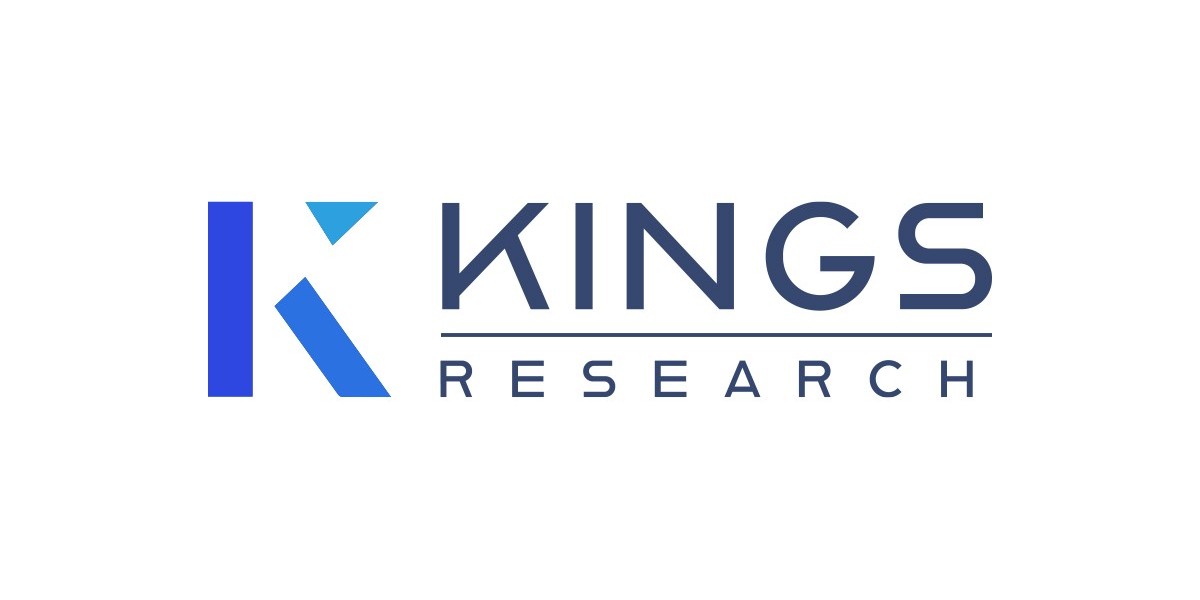The global Data Center Networking Market is entering a period of robust expansion, underpinned by surging demand for high-bandwidth, low-latency connectivity, the proliferation of hybrid and multi-cloud architectures, and the rapid growth of data volumes across industries. According to the latest research from Kings Research, the market was valued at USD 24.08 billion in 2023, and is projected to grow to USD 26.67 billion in 2024, reaching USD 60.24 billion by 2031, equating to a compound annual growth rate (CAGR) of 12.35% over the forecast period.
Market Overview
Data center networking refers to the interconnection of networking resources (switches, routers, load balancers, network virtualization, controllers, and related software) within a data center environment so as to facilitate high throughput, low latency, and secure data flow between computing, storage, and application services. It forms the core backbone on which cloud services, big data analytics, AI, and enterprise digital workloads rely.
The market’s expansion is driven by multiple converging factors:
Data Explosion & Bandwidth Demand
The proliferation of digital services — video streaming, social media, IoT endpoints, connected devices, edge computing, AI/ML workloads — is generating exponential traffic. Data centers must scale their internal networks to cope with increasing east-west traffic (server-to-server, VM-to-VM) as well as north-south traffic (inbound-outbound).Hybrid & Multi-Cloud Architectures
Enterprises are increasingly adopting hybrid (on-premises + cloud) and multi-cloud deployments to avoid vendor lock-in, optimize cost, and improve resiliency. This demands networking infrastructure that can seamlessly interconnect public clouds, private clouds, and on-prem assets — a major driver for software-defined networking (SDN), network virtualization, and overlay technologies.Virtualization & Disaggregation
The decoupling of software functions from hardware (e.g. via SDN/NFV) allows for greater flexibility, programmability, and orchestration in network management. This enables agility and automation, which are increasingly essential for modern data centers.Hyperscale & Edge Expansion
Cloud providers and hyperscalers are expanding their footprint aggressively, building new mega-data centers and regional edge facilities. Each new facility requires high-performance, scalable networking fabric to support tenants, workloads, and data replication.5G, Edge, and Low-Latency Use Cases
The rollout of 5G networks, edge computing, autonomous systems, AR/VR, high-frequency trading, and real-time analytics all place severe demands on low-latency data flow. Data center networks must evolve to meet those demands.Energy Efficiency & Cost Optimization
Networking components consume power and contribute to thermal loads. More efficient architectures (optical interconnects, passive optics, dynamic fabric control) are increasingly sought to reduce OPEX and environmental footprint.
These drivers, combined with structural investments, are fueling significant demand for next-generation networking infrastructure inside data centers.
Key Trends & Market Dynamics
Trend: Move to 400G / 800G & High-Speed Ethernet
To keep pace with rising data rates and server connectivity, adoption of 400 GbE and emerging 800 GbE interconnects is accelerating. Data centers are undergoing upgrades to higher-speed spine-leaf fabrics, with optical modules, coherent optics, and silicon photonics playing larger roles.
Trend: AI-Driven Automation & Intent-Based Networking
Networks are becoming more autonomous. Tools leveraging AI/ML for anomaly detection, self-healing, traffic prediction, and resource optimization are gaining ground. Intent-based networking (where administrators specify high-level goals and the system implements policies) is becoming central to simplifying complex operations.
Trend: Disaggregation & Open Networking
Open architectures (e.g. disaggregated switches, white-box hardware, open-source network operating systems) are gaining traction. Operators increasingly favor flexibility and vendor neutrality, decoupling hardware from software to foster innovation and cost savings.
Trend: Network Digital Twin & Simulation
With rising complexity, building digital twins of data center networks (virtual replicas) allows simulation, testing, and predictive analysis in a risk-free environment. This helps validate changes, capacity planning, and failure recovery before deploying in production.
Trend: Convergence of Compute, Storage & Network
With emerging architectures like compute-storage convergence, composable infrastructure, and memory-centric designs (e.g. disaggregated memory fabrics), the lines between compute, storage, and networking are blurring. Data center networking must evolve to support these new paradigms with low latency, high bandwidth interconnects.
Dynamic Forces: Challenges & Restraints
While growth is promising, there are headwinds and complexities:
Security & Compliance Burden: Ensuring zero-trust, microsegmentation, encryption of data in-flight, and adherence to regulatory norms (e.g. GDPR, CCPA) is not trivial.
Power & Cooling Constraints: High-speed optics and dense switch fabrics generate heat; power and cooling limits in data center racks impose constraints on how far scaling can go.
Complexity & Interoperability: As multi-vendor and multi-protocol environments proliferate, ensuring interoperability and operational simplicity becomes harder.
Cost Pressures: Upgrading legacy infrastructure, investing in new hardware and software, and retraining staff requires capital. Smaller operators may lag.
Supply Chain & Component Shortages: Delays or shortages (e.g., optical modules, ASICs, fiber optics) can retard deployments.
Legacy Migration: Transitioning from legacy architectures (e.g. 10/25/40G fabrics) to next-gen fabrics requires careful planning and may incur service disruptions.
These dynamics mean that successful players and adopters will be those able to balance innovation, scalability, efficiency, and risk management.
Market Segmentation (by Component, by End-User / Vertical)
According to Kings Research’s scope, the data center networking market is segmented by component into solutions and services, and by vertical / end-user across domains like IT & Telecom, BFSI, Healthcare, Retail / E-commerce, Manufacturing, Public Sector & Utilities, Energy, and others.
By Component: Solutions vs Services
Solution / Hardware & Software Segment
In 2023, the solution segment captured approximately 58.62% share of the market. This segment includes networking hardware (switches, routers, application delivery controllers, load balancers, and associated components) and software (controllers, orchestration, analytics). The dominance is due to the foundational nature of physical network infrastructure required to support capacity growth.Services Segment
This includes professional services (design, deployment, consulting) and managed services (monitoring, maintenance, optimization). As networks become more complex and hybrid, demand for outsourced expertise and managed offerings is growing.
Within the solution segment, subcategories typically include:
Ethernet Switches (core, aggregation, access)
Routers (for interconnect, WAN links)
Application Delivery Controllers (ADC), load balancing, traffic optimization
Network controllers, orchestration and SDN control plane software
Others (optical interconnects, network management, analytics modules)
By End-User / Vertical
IT & Telecom
This vertical is typically the largest share driver, due to telecom operators, data center providers, cloud providers, and carriers being heavy consumers of networking infrastructure. The proliferation of 5G, backhaul, edge sites, and demand for bandwidth places huge pressure on data center networking.BFSI (Banking, Financial Services & Insurance)
This sector demands high reliability, low-latency, and stringent security. Migration to cloud and digital banking drives the need for data center networking upgrades.Retail / E-Commerce
With omnichannel strategies, real-time analytics, and personalization, retailers require scalable data center infrastructure and fast networking connectivity.Healthcare
Telehealth, genomics, medical imaging, and regulatory compliance push data loads and the need for high-throughput, secure networking.Manufacturing / Industrial
With Industry 4.0, IoT sensors, predictive maintenance, and smart factories, manufacturers need robust networking infrastructure inside data centers.Public Sector & Utilities
Government services, smart city projects, utilities, and civic cloud platforms drive demand for reliable, sovereign infrastructure.Energy & Others
This includes energy, media & entertainment, and other verticals that require scalable data pipelines, content delivery, and analytics support.
Based on Kings Research’s findings, the IT & Telecom vertical is projected to register a robust CAGR of 14.11% during the forecast period, highlighting ongoing investments from telecom operators and cloud providers.
Regional / Geographic Outlook & Analysis
Geographically, the global data center networking market is often segmented into North America, Europe, Asia-Pacific, Middle East & Africa (MEA), and Latin America. The regional performance is shaped by infrastructure maturity, regulatory regimes, levels of digital transformation, and investment climate.
North America
North America accounted for the largest share in 2023 — approximately 36.81% of the market (valued at USD 8.86 billion) according to Kings Research. This dominance stems from early adoption of advanced networking paradigms, presence of hyperscale cloud providers, high R&D investment, and mature infrastructure. The U.S., in particular, serves as the epicenter of cloud, AI, and edge innovation, driving continuous upgrades of data center networking fabric.
Technology giants, telcos, and data-centric enterprises in this region push for high-performance, scalable, and energy-efficient networks. Regulation, data sovereignty concerns, and security requirements further reinforce adoption of sophisticated network architectures.
Asia-Pacific (APAC)
Asia-Pacific is poised to be the fastest-growing region during the forecast period, with a projected CAGR of 13.21% (2024–2031). The region is experiencing rapid digitization, cloud adoption, emerging 5G rollouts, smart city investments, and increased domestic demand for data localization. China, India, Japan, South Korea, Southeast Asia all contribute to this growth momentum. Governments in the region are actively promoting digital infrastructure projects and encouraging private investment in data centers.
Europe
Europe, while more conservative in adoption, is driven by regulatory imperatives (data privacy, sovereignty), cloud initiatives, the push for local cloud infrastructure (e.g., GAIA-X), and modernization of telecom networks. Key markets such as the UK, Germany, France, and the Nordics see steady growth in data center networking investments.
Middle East & Africa (MEA)
MEA is an emerging region in the data center networking space. Though its share is currently modest, governments are investing heavily in digital transformation, smart city projects, and cloud infrastructure. Gulf nations (UAE, Saudi Arabia) in particular are positioning themselves as data hubs. Investment in undersea cables, data center parks, and regional connectivity bode well for future growth.
Latin America
Latin America is also catching up, driven by growing demand for cloud services, digital transformation in banking, retail, and government sectors, and increasing infrastructure upgrades. Countries like Brazil, Mexico, Argentina are leading the growth in that region.
In sum, the regional outlook reflects a dual narrative: mature markets (North America, parts of Europe) will continue to lead through upgrades and innovation, while high-growth markets (Asia-Pacific, MEA, Latin America) will drive incremental adoption and expansion over the next decade.
Competitive Landscape & Key Players
The data center networking space is highly competitive, with established incumbents and emerging challengers vying for share through innovation, partnerships, acquisitions, and service differentiation.
According to Kings Research, the leading players profiled include:
Cisco Systems, Inc.
Dell Inc.
Arista Networks, Inc.
New H3C Technologies Co., Ltd.
Hewlett Packard Enterprise (HPE)
NVIDIA Corporation
Huawei Technologies Co. Ltd.
Juniper Networks, Inc.
Extreme Networks
IBM Corporation
Beyond these, other notable names in the broader networking ecosystem include Broadcom, VMware, Edgecore, Microsoft, Oracle, and smaller niche players in optical and open networking.
Strategic Focus Areas Among Players
Product Innovation & Next-Gen Portfolios
Major vendors are rolling out 400G / 800G switches, AI-enhanced network controllers, terabit backbone optics, silicon photonics, disaggregated switches, and advanced telemetry.Open & Disaggregated Models
Several vendors are embracing open networking and software-hardware separation to appeal to operators seeking flexibility.Partnerships & Alliances
Collaborations with cloud providers, hyperscalers, optical vendors, and systems integrators help companies expand reach and co-develop next-gen solutions.Mergers & Acquisitions
Acquisitions target complementary capabilities — for instance, in software orchestration, AI analytics, security, and optical interconnects.Regional Expansion & Localized R&D
Many players are expanding presence in high-growth geographies (Asia-Pacific, MEA) via local offices, partnerships, and manufacturing to strengthen delivery and support.
Recent Developments (Illustrative Highlights)
In March 2023, Edgecore launched the DCS520, a high-capacity 400G switch built for next-gen data center architectures, targeting cloud and high-throughput environments.
CtrlS Datacenters (India) and National Telecom (Thailand) partnered to build a hyperscale data center campus in Thailand, including full networking stack services like LAN, WAN, cloud networking, and security.
Multiple leading players have accelerated efforts in open networking stacks, disaggregation, AI-enabled network management, and alignment with cloud providers to support cross-cloud connectivity and orchestration.
Such activities reflect the intense race to deliver scalable, automated, efficient, and cloud-aligned networking solutions.
Future Outlook & Opportunities
Over the coming years, several trends and opportunities will shape the data center networking landscape:
Acceleration of 800G / Terabit Fabrics
As data volumes continue to skyrocket, upgrades to higher-speed fabrics become inevitable. Leading-edge data centers will adopt terabit-class spine-leaf topologies and converged optical interconnects.Zero-Trust & Embedded Security
Security will shift from perimeter to internal layers. Microsegmentation, in-line encryption, secure segmentation, and real-time threat analytics will be integral to network architectures.Edge Data Center Networking
With edge computing’s rise, regional micro-data centers will demand compact, power-efficient networking solutions with low-latency interconnects and remote management capabilities.Composable & Disaggregated Architectures
As compute, storage, and memory resources become composable, networking will need to flex accordingly—delivering on-demand, low-latency connectivity between disaggregated pools.AI-First Networks
AI/ML will continuously optimize routing, traffic shifts, capacity planning, and predictive maintenance. Networks will self-adjust to workload patterns and anomalies.Digital Twin, Simulation & “What-If” Testing
As the operational complexity grows, digital replicas of network fabric will be used for validating changes, training, failure recovery, and capacity scaling without risking disruption.Energy-Efficient & Green Networking
Eco-friendly and sustainable networking designs — passive optical, sleep modes, dynamic link shutdowns, and cooling-optimized layouts — will be increasingly prioritized in response to ESG pressures.Integration with Cloud & Orchestration
The network will become a first-class citizen in cloud orchestration. Seamless API-driven connectivity between on-prem, public cloud, edge, and metro clouds will be standard.Rise of Industry-specific Data Centers
Vertical-focused data centers (e.g. healthcare, finance, autonomous systems, genomics) will demand domain-optimized networking features (e.g. low-latency, specialized throughput, compliance features).Market Consolidation & Ecosystem Play
We may see more consolidation, acquisitions, and ecosystem bundling (e.g., networking + storage + compute bundles) to provide turnkey platforms.
Given the projected growth trajectory, the data center networking market offers compelling opportunities for investors, vendors, infrastructure providers, and enterprises aiming to modernize.
Regional Spotlight: Asia-Pacific & India
While North America remains the stronghold in terms of absolute share and innovation leadership, Asia-Pacific is rising fast. The region presents a significant growth engine owing to:
National digital transformation agendas (smart cities, e-governance)
Cloud adoption among enterprises
Investments by hyperscalers in local data center campuses
5G rollout and edge computing needs.
In India, for example, the data center capacity is expected to double from roughly 0.9 GW in 2023 to about 2 GW by 2026. The industry is backed by strong capital expenditure—estimated at over ₹50,000 crore (Indian rupees) over the near term. A push toward data localization, cloud adoption in government and enterprise, and edge deployment will further fuel demand for high-performance data center networking. (As per industry sources, India currently holds only ~3% share of global data center capacity despite generating ~20% of global data.)
Countries like China, Japan, South Korea, Singapore, and Malaysia also represent key strategic markets wherein domestic cloud providers, national policies, and infrastructure investments are rapidly accelerating.
Hence, vendors and investors eyeing growth must balance offerings tailored to maturity, price sensitivity, support infrastructure, and regulatory norms across regions.
Key Messages & Call to Action
The data center networking market is on a sustained, high-growth path, expected to reach USD 60.24 billion by 2031 (from USD 24.08 billion in 2023) per Kings Research estimates.
Growth is driven by the powerful convergence of data proliferation, cloud/edge expansion, 5G, AI, and digital transformation across sectors.
Key trends such as adoption of 400G/800G, disaggregation, AI-driven automation, open networking, and energy-efficient design are reshaping how networks are built and operated.
Strategic opportunities lie in edge networking, composable fabrics, security embedding, network orchestration, and green infrastructure.
In a highly competitive landscape, vendors must differentiate through innovation, agility, service excellence, partnerships, and localized execution.
Regional dynamics suggest that while North America will remain a foundation, Asia-Pacific (especially India, China) and emerging regions (MEA, Latin America) will deliver disproportionate growth.
We encourage enterprises, service providers, cloud operators, and technology vendors to strategically invest in future-proofing their networking infrastructure now. The next decade in data center networking will be about transforming from rigid, opaque fabrics into adaptive, software-driven, intent-based, security-embedded, energy-aware networks. Those who lead in this transition will define the digital backbone of tomorrow’s world.
Browse To Related Article-
NEC to Secure GREEN×EXPO 2027 in Yokohama, Japan
ITBusinessToday Weekly News RoundUp Seven-Eleven, Mitsubishi Electric, Money Forward, Toyota & More







